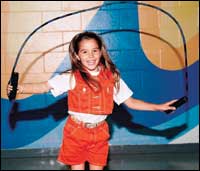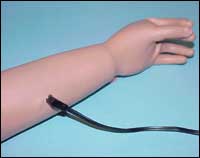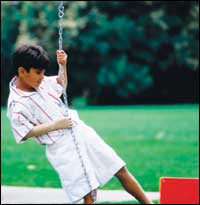 |
| Figure 1 |
Children’s activities often place severe demands on their prosthetic systems. Children are not just small adults, yet for many years pediatric upper-limb prostheses were simply smaller, less-versatile versions of their adult counterparts. Before technology gave us the means to accommodate children’s unique size, strength, and lifestyle characteristics, we regularly saw children refusing to wear their prosthetic arms, or trying to wear arms with substandard design and components. Not wanting to see their children struggling, parents sometimes were unable or unwilling to provide the necessary motivation.
Fortunately, those days are over.
Technological advances in microprocessors, batteries, and socket
design have opened the door for the success of children with
prosthetic arms. The newest upper-limb
prosthetic technology makes it possible to create children’s
prostheses that are smaller, lighter, more lifelike, more
comfortable, more functional, and easier to repair than ever before
[Figure 1].
Since children are still developing, their prosthetic systems
must be able to grow with them, both physically and functionally.
Changes in fitting protocols and components now allow these
prosthetic systems to grow with the child.
Advances in Batteries, Design, Components
Children’s hands create unique size and weight constraints for
prosthetic components. Batteries, wrist units, and the hands
themselves must be smaller and lighter than adult models. Since the
battery is the heaviest component in the system after the electric
hand, it is important that prosthetic controllers use energy
wisely. The new classes of controller circuits have energy-saving
features to conserve battery power, and they can operate with
smaller, lighter Lithium-ion (Li-ion) batteries. Li-ion batteries
provide up to 100 percent more battery capacity than traditional
Nickel-Cadmium (NiCad) batteries, yet weigh 20 percent less.
 |
| Figure 2 |
High-capacity Li-ion batteries make it possible to operate a child’s prosthesis for a full day or more. The small, built-in batteries are concealed, so the outer prosthesis is more attractive, and it is easy for children to recharge their battery by simply plugging the charger cord into a connector on the forearm [Figure 2]. With the older style batteries, when a prosthetic arm lost power–at school, for example–the child had to go through the rest of the day without use of the arm. A full recharge took more than five hours. With the new Li-ion batteries, a quick 30-minute charge will provide enough power to allow full use of the prosthesis for the remainder of the day. But with the increased capacity of these new batteries, loss of power can usually be avoided altogether.
Advancements in lightweight components, coupled with a drastic
socket design change within the past five years, allow children to
be fit at a much earlier age. We are now successfully fitting
electric arms on infants less than one year old. New sockets allow
for children to maximize function through an increased range of
motion, control of the electronics, inherent suspension without the
need for sleeves or straps, and all-day wearing comfort. The single
most important advantage of early fitting is the immediate
acceptance of the prosthetic arm by the child. No longer just a
“helper-hand,” the prosthesis is a normal part of their body
[Figure 3 on page 38].
Rehab Roles Must Continue
Throughout the child’s life, the aggressive roles of the
rehabilitation team must continue. Comparison of computerized
documentation of prosthetic usage and EMG signals allows the rehab
team to assess proper therapy protocols and insurance justification
for therapy continuance. Electronic adjustments to the prosthesis
provide better function as the child develops finer control of the
residual limb musculature. Adjustments of the electronics, such as
gains and thresholds, must be made as muscle control and stamina
increase in the growing child. The new microprocessor-based
controllers allow practitioners to make instant changes to adjust
the prosthesis to the precise level of optimal control.
 |
| Figure 3 |
Because of the early age of fitting, some children cannot differentiate between two muscle groups, so they are fit as a single-site control. Although a single control site can still offer proportional control of speed and grip strength, it is not as efficient as dual-site control. However, with increased time of wearing and adequate therapy, children are able to differentiate antagonistic muscle groups at approximately three years of age. Once this differentiation is developed, it is possible to switch the single-site to a dual-site control with a simple office visit adjustment. In the past, making this change required new components or even a whole new prosthesis. Dual-site control offers true EMG signal through the electrode, rather than a rub-up-against-the-electrode, threshold type of control.
Advances Increase Parental Acceptance
Since most of these advancements are relatively new to the field
of prosthetics, we do not yet have long-term outcomes. However,
those who have worn prosthetics as children do have one thing in
common: most attribute their current success with the prosthesis to
the involvement and motivation given by their parents. The
advancements in electronics and socket design have been helpful in
increasing parental involvement and acceptance of a child’s
prosthesis as well. Gone are the days of the frightening-looking
hook and cumbersome harness. Today, parents see their children
benefit from a comfortable prosthesis with a soft contouring socket
that allows for growth and a natural-looking hand. This increase in
parental acceptance is especially seen after the parents view the
ease of electronic adjustments and witness their children wanting
to wear the arm, rather than feeling they have to wear it because
Mom told them to.
Ultimately, parental involvement, improved socket design, and
computerized controllers lead to more children wearing electric
arms at an earlier age and being more successful and functional
than in years past. This success drives the technology forward and
results in continuous improvements, providing new clinical and
technological opportunities in pediatrics.
William Hanson, MS, is president of Liberating Technologies, Inc., Holliston, Massachusetts, a company which designs and
Stephen Mandacina, CP, FAAOP, is manager of the Hanger P&O Upper-Extremity Pediatrics Program and a national specialist for Hanger’s Upper-Extremity Program. He lives in Kansas City, Missouri, but travels full time fitting patients and presenting on UE pr




